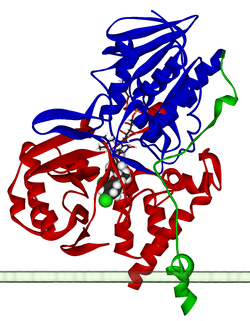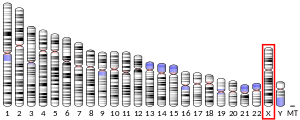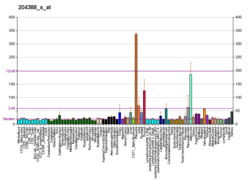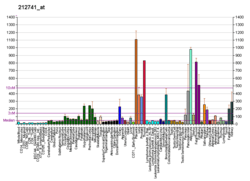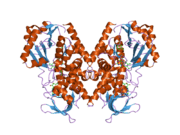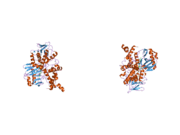Monoamine oxidase A
Monoamine oxidase A, also known as MAO-A, is an enzyme that in humans is encoded by the MAOA gene.[5][6] This gene is one of two neighboring gene family members that encode mitochondrial enzymes which catalyze the oxidative deamination of amines, such as dopamine, norepinephrine, and serotonin. A mutation of this gene results in Brunner syndrome. This gene has also been associated with a variety of other psychiatric disorders, including antisocial behavior. Alternatively spliced transcript variants encoding multiple isoforms have been observed.[7]

Structures
Gene
Monoamine oxidase A, also known as bts , is an enzyme that in humans is encoded by the MAOA gene.[5][6] The promoter of MAOA contains conserved binding sites for Sp1, GATA2, and TBP.[8] This gene is adjacent to a related gene (MAOB) on the opposite strand of the X chromosome.
In humans, there is a 30-base repeat sequence repeated several different numbers of times in the promoter region of MAO-A. There are 2R (two repeats), 3R, 3.5R, 4R, and 5R variants of the repeat sequence, with the 3R and 4R variants most common in Caucasians. The 3.5R and 4R variants have been found to be more highly active than 3R or 5R, in a study which did not examine the 2R variant.[9]
Studies have found differences in the frequency distribution of variants of the MAOA gene between ethnic groups:[9][10] of the participants, 36% of Black men, 54% of Chinese men, 56% of Maori men, and 65% of Caucasian men carried the 3R allele, while 5.5% of Black men, 0.1% of Caucasian men, and 0.00067% of Asian men carried the 2R allele.[11][9][10][12][13][14][15][16][17][18]
The epigenetic modification of MAOA gene expression through methylation likely plays an important role in women.[19] A study from 2010 found epigenetic methylation of MAOA in men to be very low and with little variability compared to women, while having higher heritability in men than women.[20]
Protein
The gene encodes a monomeric protein which shares a 70% amino acid sequence identity, as well as conserved chain folds and flavin adenine dinucleotide (FAD)-binding site structures, with MAO-B. However, MAO-A has a monopartite cavity of approximately 550 angstroms, compared to the 290-angstrom bipartite cavity in MAO-B. Nonetheless, both proteins adopt dimeric forms when membrane-bound. The C-terminal domain of MAO-A forms helical tails which are responsible for attaching the protein to the outer mitochondrial membrane (OMM). MAO-A contains loop structures at the entrance of its active site.[21]
Function
MAO-A is a key regulator for normal brain function. It is a flavoenzyme which degrades amine neurotransmitters, such as dopamine, norepinephrine, and serotonin, via oxidative deamination. It is highly expressed in neural and cardiac cells and localizes to the outer mitochondrial membrane. Its expression is regulated by the transcription factors SP1, GATA2, and TBP via the CAMP pathway in response to stress such as ischemia and inflammation.[8] The 2R allele has been linked by several studies to an increase in violent behavior in adolescents and young adults.[12][22]
Clinical significance
Cancer
MAO-A produces an amine oxidase, which is a class of enzyme known to affect carcinogenesis. Clorgyline, an MAO-A enzyme inhibitor, prevents apoptosis in melanoma cells, in vitro.[23] Cholangiocarcinoma suppresses MAO-A expression, and those patients with higher MAO-A expression had less adjacent organ invasion and better prognosis and survival.[24]
Cardiovascular disease
MAOA activity is linked to apoptosis and cardiac damage during cardiac injury following ischemic-reperfusion.[8]
Behavioral and neurological disorders
There is some association between low activity forms of the MAOA gene and autism.[25] Mutations in the MAOA gene results in monoamine oxidase deficiency, or Brunner syndrome.[7] Other disorders associated with MAO-A include Alzheimer's disease, aggression, panic disorder, bipolar affective disorder, major depressive disorder, and attention deficit hyperactivity disorder.[8] Effects of parenting on self-regulation in adolescents appear to be moderated by 'plasticity alleles', of which the 2R and 3R alleles of MAOA are two, with "the more plasticity alleles males (but not females) carried, the more and less self-regulation they manifested under, respectively, supportive and unsupportive parenting conditions."[26]
Depression
MAO-A levels in the brain as measured using positron emission tomography are elevated by an average of 34% in patients with major depressive disorder.[27] Genetic association studies examining the relationship between high-activity MAOA variants and depression have produced mixed results, with some studies linking the high-activity variants to major depression in females,[28] depressed suicide in males,[29] major depression and sleep disturbance in males[30] and major depressive disorder in both males and females.[31]
Other studies failed to find a significant relationship between high-activity variants of the MAOA gene and major depressive disorder.[32][33] In patients with major depressive disorder, those with MAOA G/T polymorphisms (rs6323) coding for the highest-activity form of the enzyme have a significantly lower magnitude of placebo response than those with other genotypes.[34]
Antisocial behavior
In humans, an association between the 2R allele of the VNTR region of the gene and an increase in the likelihood of committing serious crime or violence has been found.[35][36][11]
A connection between the MAO-A gene 3R version and several types of anti-social behaviour has been found: Maltreated children with genes causing high levels of MAO-A were less likely to develop antisocial behavior.[37] Low MAO-A activity alleles which are overwhelmingly the 3R allele in combination with abuse experienced during childhood resulted in an increased risk of aggressive behaviour as an adult,[38] and men with the low activity MAOA allele were more genetically vulnerable even to punitive discipline as a predictor of antisocial behaviour.[39] High testosterone, maternal tobacco smoking during pregnancy, poor material living standards, dropping out of school, and low IQ predicted violent behavior are associated with men with the low-activity alleles.[40][41] The low-activity 3-repeat allele variant of the MAOA gene has also been found to occur frequently in men who join gangs.[42] According to a large meta-analysis in 2014, the 3R allele had a small main effect on aggression and antisocial behavior, even in the absence of other interaction factors.[43]
Aggression and the "Warrior gene"
A variant of the monoamine oxidase-A gene has been popularly referred to as the warrior gene.[44] Several different versions of the gene are found in different individuals, although a functional gene is present in most humans (with the exception of a few individuals with Brunner syndrome).[45] In the variant, the allele associated with behavioural traits is shorter (30 bases) and may produce less MAO-A enzyme.[9] This gene variation is in a regulatory promoter region about 1,000 bases from the start of the region that encodes the MAO-A enzyme.
When faced with social exclusion or ostracism, individuals with the low activity MAOA gene showed higher levels of aggression than individuals with the high activity MAOA gene.[46] Low activity MAO-A could significantly predict aggressive behaviour in a high provocation situation, but was less associated with aggression in a low provocation situation. Individuals with the low activity variant of the MAOA gene were just as likely as participants with the high activity variant to retaliate when the loss was small. However, they were more likely to retaliate and with greater force when the loss was large.[47]
"Monoamine oxidases (MAOs) are enzymes that are involved in the breakdown of neurotransmitters such as serotonin and dopamine and are, therefore, capable of influencing feelings, mood, and behaviour of individuals".[48] According to this, if there was a mutation to the gene that is involved in the process of promoting or inhibiting MAO enzymes, it could affect a person's personality or behaviour and could therefore make them more prone to aggression. A deficiency in the MAOA gene has shown higher levels of aggression in males, which could further stimulate more research into this controversial topic. "A deficiency in monoamine oxidase A (MAO-A) has been shown to be associated with aggressive behaviour in men of a Dutch family".[49]
The "warrior gene" was the first candidate gene for antisocial behavior and was identified during a "molecular genetic analysis of a large, multigenerational, and notoriously violent, Dutch kindred".[50] A study of Finnish prisoners revealed that a MAOA-L (low-activity) genotype, which contributes to low dopamine turnover rate, was associated with extremely violent behavior.[51] For the purpose of the study, "extremely violent behavior" was defined as at least ten committed homicides, attempted homicides or batteries.
Legal implications
In a 2009 criminal trial in the United States, an argument based on a combination of "warrior gene" and history of child abuse was successfully used to avoid a conviction of first-degree murder and the death penalty; however, the convicted murderer was sentenced to 32 years in prison.[52][53]
Epigenetics
Studies have linked methylation of the MAOA gene with nicotine and alcohol dependence in women.[54] A second MAOA VNTR promoter, P2, influences epigenetic methylation and interacts with having experienced child abuse to influence antisocial personality disorder symptoms, only in women.[55]
Animal studies
A dysfunctional MAOA gene has been correlated with increased aggression levels in mice,[56][57] and has been correlated with heightened levels of aggression in humans.[58] In mice, a dysfunctional MAOA gene is created through insertional mutagenesis (called ‘Tg8’).[56] Tg8 is a transgenic mouse strain that lacks functional MAO-A enzymatic activity. Mice that lacked a functional MAOA gene exhibited increased aggression towards intruder mice.[56][59]
Some types of aggression exhibited by these mice were territorial aggression, predatory aggression, and isolation-induced aggression.[57] The MAO-A deficient mice that exhibited increased isolation-induced aggression reveals that an MAO-A deficiency may also contribute to a disruption in social interactions.[60] There is research in both humans and mice to support that a nonsense point mutation in the eighth exon of the MAOA gene is responsible for impulsive aggressiveness due to a complete MAO-A deficiency.[56][58]
Interactions
Transcription factors
A number of transcription factors bind to the promoter region of MAO-A and upregulate its expression. These include:Sp1 transcription factor, GATA2, TBP.[8]
Inducers
Synthetic compounds that up-regulate the expression of MAO-A include Valproic acid (Depakote)[61]
Inhibitors
Substances that inhibit the enzymatic activity of MAO-A include:
- Synthetic compounds
- Befloxatone (MD370503)
- Brofaromine (Consonar)
- Cimoxatone
- Clorgyline (irreversible)
- Methylene Blue
- Minaprine (Cantor)
- Moclobemide (Aurorix, Manerix)
- Phenelzine (Nardil)
- Pirlindole (Pirazidol)
- Toloxatone (Humoryl)
- Tyrima (CX 157)
- Tranylcypromine (nonselective and irreversible)
- Natural products
- Incarviatone A
- Herbal sources
- Garlic (Garlic)
- Harmala Alkaloids (Syrian Rue, Passion Flower, Ayahuasca)
- Piperine (Black pepper)[62]
See also
References
- GRCh38: Ensembl release 89: ENSG00000189221 - Ensembl, May 2017
- GRCm38: Ensembl release 89: ENSMUSG00000025037 - Ensembl, May 2017
- "Human PubMed Reference:". National Center for Biotechnology Information, U.S. National Library of Medicine.
- "Mouse PubMed Reference:". National Center for Biotechnology Information, U.S. National Library of Medicine.
- Hotamisligil GS, Breakefield XO (Aug 1991). "Human monoamine oxidase A gene determines levels of enzyme activity". American Journal of Human Genetics. 49 (2): 383–92. PMC 1683299. PMID 1678250.
- Grimsby J, Chen K, Wang LJ, Lan NC, Shih JC (May 1991). "Human monoamine oxidase A and B genes exhibit identical exon-intron organization". Proceedings of the National Academy of Sciences of the United States of America. 88 (9): 3637–41. Bibcode:1991PNAS...88.3637G. doi:10.1073/pnas.88.9.3637. PMC 51507. PMID 2023912.
- "Entrez Gene: MAOA monoamine oxidase A".
- Gupta V, Khan AA, Sasi BK, Mahapatra NR (Jul 2015). "Molecular mechanism of monoamine oxidase A gene regulation under inflammation and ischemia-like conditions: key roles of the transcription factors GATA2, Sp1 and TBP". Journal of Neurochemistry. 134 (1): 21–38. doi:10.1111/jnc.13099. PMID 25810277.
- Sabol SZ, Hu S, Hamer D (Sep 1998). "A functional polymorphism in the monoamine oxidase A gene promoter". Human Genetics. 103 (3): 273–9. doi:10.1007/s004390050816. PMID 9799080.
- Lea R, Chambers G (2007). "Monoamine oxidase, addiction, and the "warrior" gene hypothesis". The New Zealand Medical Journal. 120 (1250): U2441. PMID 17339897. Archived from the original on 2011-12-25. Retrieved 2011-12-31.
- Beaver KM, et al. (2012). "Exploring the association between the 2-repeat allele of the MAOA gene promoter polymorphism and psychopathic personality traits, arrests, incarceration, and lifetime antisocial behavior". Personality and Individual Differences. 54 (2): 164–168. doi:10.1016/j.paid.2012.08.014.
- Lu RB, Lin WW, Lee JF, Ko HC, Shih JC (Jun 2003). "Neither antisocial personality disorder nor antisocial alcoholism is associated with the MAO-A gene in Han Chinese males". Alcoholism: Clinical and Experimental Research. 27 (6): 889–93. doi:10.1097/01.ALC.0000071927.64880.0E. PMID 12824808.
- Zhang M, Chen X, Way N, Yoshikawa H, Deng H, Ke X, Yu W, Chen P, He C, Chi X, Lu Z (Sep 2011). "The association between infants' self-regulatory behavior and MAOA gene polymorphism". Developmental Science. 14 (5): 1059–65. doi:10.1111/j.1467-7687.2011.01047.x. PMID 21884321.
- Zhou Q, Hofer C, Eisenberg N, Reiser M, Spinrad TL, Fabes RA (Mar 2007). "The developmental trajectories of attention focusing, attentional and behavioral persistence, and externalizing problems during school-age years". Developmental Psychology. 43 (2): 369–385. doi:10.1037/0012-1649.43.2.369. PMC 1832154. PMID 17352545.
- Chen SY, Wang J, Yu GQ, Liu W, Pearce D (May 1997). "Androgen and glucocorticoid receptor heterodimer formation. A possible mechanism for mutual inhibition of transcriptional activity". The Journal of Biological Chemistry. 272 (22): 14087–92. doi:10.1074/jbc.272.22.14087. PMID 9162033.
- Ono H, Shirakawa O, Nishiguchi N, Nishimura A, Nushida H, Ueno Y, Maeda K (Apr 2002). "No evidence of an association between a functional monoamine oxidase a gene polymorphism and completed suicides" (PDF). American Journal of Medical Genetics. 114 (3): 340–2. doi:10.1002/ajmg.10237. PMID 11920860.
- Wang TJ, Huang SY, Lin WW, Lo HY, Wu PL, Wang YS, Wu YS, Ko HC, Shih JC, Lu RB (Jan 2007). "Possible interaction between MAOA and DRD2 genes associated with antisocial alcoholism among Han Chinese men in Taiwan". Progress in Neuro-Psychopharmacology & Biological Psychiatry. 31 (1): 108–114. doi:10.1016/j.pnpbp.2006.08.010. PMID 17007976.
- Lee SY, Hahn CY, Lee JF, Huang SY, Chen SL, Kuo PH, Lee IH, Yeh TL, Yang YK, Chen SH, Ko HC, Lu RB (Jul 2010). "MAOA interacts with the ALDH2 gene in anxiety-depression alcohol dependence". Alcoholism: Clinical and Experimental Research. 34 (7): 1212–8. doi:10.1111/j.1530-0277.2010.01198.x. PMID 20477771.
- Jiang Y, Langley B, Lubin FD, Renthal W, Wood MA, Yasui DH, Kumar A, Nestler EJ, Akbarian S, Beckel-Mitchener AC (Nov 2008). "Epigenetics in the nervous system". The Journal of Neuroscience. 28 (46): 11753–9. doi:10.1523/JNEUROSCI.3797-08.2008. PMC 3844836. PMID 19005036.
- Wong CC, Caspi A, Williams B, Craig IW, Houts R, Ambler A, Moffitt TE, Mill J (Aug 2010). "A longitudinal study of epigenetic variation in twins". Epigenetics. 5 (6): 516–26. doi:10.4161/epi.5.6.12226. PMC 3322496. PMID 20505345.
- Binda C, Mattevi A, Edmondson DE (2011). "Structural properties of human monoamine oxidases a and B". Monoamine Oxidase and their Inhibitors. International Review of Neurobiology. 100. pp. 1–11. doi:10.1016/B978-0-12-386467-3.00001-7. ISBN 9780123864673. PMID 21971000.
- Beaver, Kevin M.; Barnes, J. C.; Boutwell, Brian B. (September 2014). "The 2-repeat allele of the MAOA gene confers an increased risk for shooting and stabbing behaviors". The Psychiatric Quarterly. 85 (3): 257–265. doi:10.1007/s11126-013-9287-x. ISSN 1573-6709. PMID 24326626.
- Pietrangeli P, Mondovì B (Jan 2004). "Amine oxidases and tumors". Neurotoxicology. 25 (1–2): 317–24. doi:10.1016/S0161-813X(03)00109-8. PMID 14697906.
- Huang L, Frampton G, Rao A, Zhang KS, Chen W, Lai JM, Yin XY, Walker K, Culbreath B, Leyva-Illades D, Quinn M, McMillin M, Bradley M, Liang LJ, DeMorrow S (Oct 2012). "Monoamine oxidase A expression is suppressed in human cholangiocarcinoma via coordinated epigenetic and IL-6-driven events". Laboratory Investigation. 92 (10): 1451–60. doi:10.1038/labinvest.2012.110. PMC 3959781. PMID 22906985.
- Cohen IL, Liu X, Lewis ME, Chudley A, Forster-Gibson C, Gonzalez M, Jenkins EC, Brown WT, Holden JJ (Apr 2011). "Autism severity is associated with child and maternal MAOA genotypes". Clinical Genetics. 79 (4): 355–62. doi:10.1111/j.1399-0004.2010.01471.x. PMID 20573161.
- Belsky J, Beaver KM (May 2011). "Cumulative-genetic plasticity, parenting and adolescent self-regulation". Journal of Child Psychology and Psychiatry. 52 (5): 619–626. doi:10.1111/j.1469-7610.2010.02327.x. PMC 4357655. PMID 21039487.
- Meyer JH, Ginovart N, Boovariwala A, Sagrati S, Hussey D, Garcia A, Young T, Praschak-Rieder N, Wilson AA, Houle S (Nov 2006). "Elevated monoamine oxidase a levels in the brain: an explanation for the monoamine imbalance of major depression". Archives of General Psychiatry. 63 (11): 1209–16. doi:10.1001/archpsyc.63.11.1209. PMID 17088501.
- Schulze TG, Müller DJ, Krauss H, Scherk H, Ohlraun S, Syagailo YV, Windemuth C, Neidt H, Grässle M, Papassotiropoulos A, Heun R, Nöthen MM, Maier W, Lesch KP, Rietschel M (Dec 2000). "Association between a functional polymorphism in the monoamine oxidase A gene promoter and major depressive disorder". American Journal of Medical Genetics. 96 (6): 801–3. doi:10.1002/1096-8628(20001204)96:6<801::AID-AJMG21>3.0.CO;2-4. PMID 11121185.
- Du L, Faludi G, Palkovits M, Sotonyi P, Bakish D, Hrdina PD (Jul 2002). "High activity-related allele of MAO-A gene associated with depressed suicide in males". NeuroReport. 13 (9): 1195–8. doi:10.1097/00001756-200207020-00025. PMID 12151768.
- Du L, Bakish D, Ravindran A, Hrdina PD (Sep 2004). "MAO-A gene polymorphisms are associated with major depression and sleep disturbance in males". NeuroReport. 15 (13): 2097–101. doi:10.1097/00001756-200409150-00020. PMID 15486489.
- Yu YW, Tsai SJ, Hong CJ, Chen TJ, Chen MC, Yang CW (Sep 2005). "Association study of a monoamine oxidase a gene promoter polymorphism with major depressive disorder and antidepressant response". Neuropsychopharmacology. 30 (9): 1719–23. doi:10.1038/sj.npp.1300785. PMID 15956990.
- Serretti A, Cristina S, Lilli R, Cusin C, Lattuada E, Lorenzi C, Corradi B, Grieco G, Costa A, Santorelli F, Barale F, Nappi G, Smeraldi E (May 2002). "Family-based association study of 5-HTTLPR, TPH, MAO-A, and DRD4 polymorphisms in mood disorders". American Journal of Medical Genetics. 114 (4): 361–9. doi:10.1002/ajmg.10356. PMID 11992558.
- Huang SY, Lin MT, Lin WW, Huang CC, Shy MJ, Lu RB (2009). "Association of monoamine oxidase A (MAOA) polymorphisms and clinical subgroups of major depressive disorders in the Han Chinese population". The World Journal of Biological Psychiatry. 10 (4 Pt 2): 544–51. doi:10.1080/15622970701816506. PMID 19224413.
- Leuchter AF, McCracken JT, Hunter AM, Cook IA, Alpert JE (Aug 2009). "Monoamine oxidase a and catechol-o-methyltransferase functional polymorphisms and the placebo response in major depressive disorder". Journal of Clinical Psychopharmacology. 29 (4): 372–7. doi:10.1097/JCP.0b013e3181ac4aaf. PMID 19593178.
- Guo G, Ou XM, Roettger M, Shih JC (May 2008). "The VNTR 2 repeat in MAOA and delinquent behavior in adolescence and young adulthood: associations and MAOA promoter activity". European Journal of Human Genetics. 16 (5): 626–34. doi:10.1038/sj.ejhg.5201999. PMC 2922855. PMID 18212819.
- Guo G, Roettger M, Shih JC (August 2008). "The integration of genetic propensities into social-control models of delinquency and violence among male youths" (PDF). American Sociological Review. 73 (4): 543–568. doi:10.1177/000312240807300402. Archived from the original (PDF) on December 2, 2008. Retrieved 2009-02-16.
- Caspi A, McClay J, Moffitt TE, Mill J, Martin J, Craig IW, Taylor A, Poulton R (Aug 2002). "Role of genotype in the cycle of violence in maltreated children". Science. 297 (5582): 851–4. Bibcode:2002Sci...297..851C. doi:10.1126/science.1072290. PMID 12161658. Lay summary – eurekalert.org (2002-08-01).
- Frazzetto G, Di Lorenzo G, Carola V, Proietti L, Sokolowska E, Siracusano A, Gross C, Troisi A (2007). "Early trauma and increased risk for physical aggression during adulthood: the moderating role of MAOA genotype". PLOS One. 2 (5): e486. Bibcode:2007PLoSO...2..486F. doi:10.1371/journal.pone.0000486. PMC 1872046. PMID 17534436.
- Choe DE, Shaw DS, Hyde LW, Forbes EE (September 2014). "Interactions Between Monoamine Oxidase A and Punitive Discipline in African American and Caucasian Men's Antisocial Behavior". Clinical Psychological Science. 2 (5): 591–601. doi:10.1177/2167702613518046. PMC 4802365. PMID 27014508.
- Fergusson DM, Boden JM, Horwood LJ, Miller A, Kennedy MA (Feb 2012). "Moderating role of the MAOA genotype in antisocial behaviour". The British Journal of Psychiatry. 200 (2): 116–23. doi:10.1192/bjp.bp.111.093328. PMC 3269651. PMID 22297589.
- Sjöberg RL, Ducci F, Barr CS, Newman TK, Dell'osso L, Virkkunen M, Goldman D (Jan 2008). "A non-additive interaction of a functional MAO-A VNTR and testosterone predicts antisocial behavior". Neuropsychopharmacology. 33 (2): 425–30. doi:10.1038/sj.npp.1301417. PMC 2665792. PMID 17429405.
- The role of gene-gene interaction in the prediction of criminal behavior.
- Ficks CA, Waldman ID (Sep 2014). "Candidate genes for aggression and antisocial behavior: a meta-analysis of association studies of the 5HTTLPR and MAOA-uVNTR". Behavioral Genetics. 44 (5): 427–44. doi:10.1007/s10519-014-9661-y. PMID 24902785.
- Hogenboom M (28 October 2014). "Share this pageEmail Print Share this page". BBC News. Retrieved 2014-11-01.
- Online Mendelian Inheritance in Man (OMIM): MONOAMINE OXIDASE A; MAOA. - 309850
- Gallardo-Pujol D, Andrés-Pueyo A, Maydeu-Olivares A (Feb 2013). "MAOA genotype, social exclusion and aggression: an experimental test of a gene-environment interaction". Genes, Brain, and Behavior. 12 (1): 140–145. doi:10.1111/j.1601-183X.2012.00868.x. PMID 23067570.
- McDermott R, Tingley D, Cowden J, Frazzetto G, Johnson DD (Feb 2009). "Monoamine oxidase A gene (MAOA) predicts behavioral aggression following provocation". Proceedings of the National Academy of Sciences of the United States of America. 106 (7): 2118–23. Bibcode:2009PNAS..106.2118M. doi:10.1073/pnas.0808376106. PMC 2650118. PMID 19168625.
- Hook GR (2009). ""Warrior genes" and the disease of being Māori". MAI Review (2): 1–11. Archived from the original on 2014-09-07. Retrieved 2012-12-12.
- Cases O, Seif I, Grimsby J, Gaspar P, Chen K, Pournin S, Müller U, Aguet M, Babinet C, Shih JC (Jun 1995). "Aggressive behavior and altered amounts of brain serotonin and norepinephrine in mice lacking MAOA". Science. 268 (5218): 1763–6. Bibcode:1995Sci...268.1763C. doi:10.1126/science.7792602. PMC 2844866. PMID 7792602.
- Dorfman, Haley M., Meyer-Lindenberg Andreas, Buckholtz Joshua W. 2014. Neurobiological Mechanisms for Impulsive-Aggression: The role of MAOA. Curr. Top. Behav. Neuro., 17:297–313
- Tiihonen, J., et al. 2015. Genetic Background of Extreme Violent Behavior. Molecular Psychiatry, 20:786-792
- Barber N (2010-07-13). "Pity the poor murderer, his genes made him do it". Psychology Today. Blog: "The Human Beast: Why we do what we do". Retrieved 2010-10-17.
- Hagerty BB (2010-07-01). "Can Your Genes Make You Murder?". News > Science > Inside The Criminal Brain. National Public Radio. Retrieved 2010-10-17.
- Philibert RA, Gunter TD, Beach SR, Brody GH, Madan A (Jul 2008). "MAOA methylation is associated with nicotine and alcohol dependence in women". American Journal of Medical Genetics Part B. 147B (5): 565–70. doi:10.1002/ajmg.b.30778. PMC 3685146. PMID 18454435.
- Philibert RA, Wernett P, Plume J, Packer H, Brody GH, Beach SR (Jul 2011). "Gene environment interactions with a novel variable Monoamine Oxidase A transcriptional enhancer are associated with antisocial personality disorder". Biological Psychology. 87 (3): 366–71. doi:10.1016/j.biopsycho.2011.04.007. PMC 3134149. PMID 21554924.
- Scott AL, Bortolato M, Chen K, Shih JC (May 2008). "Novel monoamine oxidase A knock out mice with human-like spontaneous mutation". NeuroReport. 19 (7): 739–43. doi:10.1097/WNR.0b013e3282fd6e88. PMC 3435113. PMID 18418249.
- Vishnivetskaya GB, Skrinskaya JA, Seif I, Popova NK (2007). "Effect of MAO A deficiency on different kinds of aggression and social investigation in mice". Aggressive Behavior. 33 (1): 1–6. doi:10.1002/ab.20161. PMID 17441000.
- Brunner HG, Nelen M, Breakefield XO, Ropers HH, van Oost BA (Oct 1993). "Abnormal behavior associated with a point mutation in the structural gene for monoamine oxidase A". Science. 262 (5133): 578–80. Bibcode:1993Sci...262..578B. doi:10.1126/science.8211186. PMID 8211186.
- Vishnivetskaya GB, Skrinskaya JA, Seif I, Popova NK (1 January 2007). "Effect of MAO A deficiency on different kinds of aggression and social investigation in mice". Aggressive Behavior. 33 (1): 1–6. doi:10.1002/ab.20161. PMID 17441000.
- Hebebrand J, Klug B (Sep 1995). "Specification of the phenotype required for men with monoamine oxidase type A deficiency". Human Genetics. 96 (3): 372–6. doi:10.1007/BF00210430. PMID 7649563.
- Wu JB, Shih JC (Oct 2011). "Valproic acid induces monoamine oxidase A via Akt/forkhead box O1 activation". Molecular Pharmacology. 80 (4): 714–723. doi:10.1124/mol.111.072744. PMC 3187529. PMID 21775495.
- Lee, S. A.; Hong, S. S.; Han, X. H.; Hwang, J. S.; Oh, G. J.; Lee, K. S.; Lee, M. K.; Hwang, B. Y.; Ro, J. S. (2005). "Piperine from the fruits of Piper longum with inhibitory effect on monoamine oxidase and antidepressant-like activity". Chemical & Pharmaceutical Bulletin. 53 (7): 832–5. doi:10.1248/cpb.53.832. PMID 15997146.
Further reading
- Rehan W, Sandnabba NK, Johansson A, Westberg L, Santtila P (October 2015). "Effects of MAOA genotype and childhood experiences of physical and emotional abuse on aggressive behavior in adulthood". Nordic Psychology. 67 (4): 301–12. doi:10.1080/19012276.2015.1026922.
- McDermott R, Tingley D, Cowden J, Frazzetto G, Johnson DD (Feb 2009). "Monoamine oxidase A gene (MAOA) predicts behavioral aggression following provocation". Proceedings of the National Academy of Sciences of the United States of America. 106 (7): 2118–23. Bibcode:2009PNAS..106.2118M. doi:10.1073/pnas.0808376106. PMC 2650118. PMID 19168625.
- Edmondson DE, Binda C, Mattevi A (Jan 2004). "The FAD binding sites of human monoamine oxidases A and B". Neurotoxicology. 25 (1–2): 63–72. doi:10.1016/S0161-813X(03)00114-1. PMID 14697881.
- Craig IW (Mar 2007). "The importance of stress and genetic variation in human aggression". BioEssays. 29 (3): 227–36. doi:10.1002/bies.20538. PMID 17295220.
External links
- Overview of all the structural information available in the PDB for UniProt: P21397 (Human Monoamine oxidase A) at the PDBe-KB.
| Wikimedia Commons has media related to Monoamine oxidase A. |
